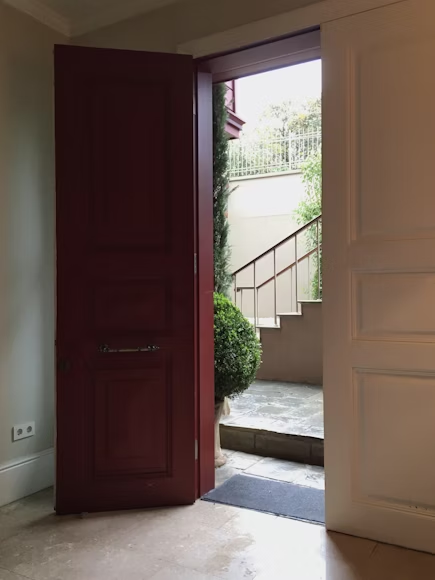By George House/12,Aug,2025

(Source)
Choosing the right standard door frame width is more important than many homeowners realize. An incorrect size can lead to installation problems, wasted time, and higher costs. Understanding measurements such as the average door frame width and how they fit into your space ensures your doors open and close properly.
The right frame width also enhances appearance and security. This guide explains key dimensions, installation tips, and common frame widths you’ll encounter. Whether you’re building, replacing, or renovating, accurate knowledge makes the process smoother. Let’s walk through everything you need to know about measuring and selecting the proper door frame width.
Understanding Standard Door Frame Width
Before installation, knowing what counts as the typical door frame measurements is essential. In most U.S. homes, interior door frame widths often range between 30 and 36 inches. According to the U.S. Department of Housing and Urban Development (HUD), accessibility guidelines recommend at least a 32-inch clear opening for most doorways.
This ensures comfortable passage for all users, including those using mobility aids. A report from the National Institute of Standards and Technology (NIST) highlights that precision in measurement reduces installation errors significantly. All in all, it is safe to say that getting the measurement right is highly vital.
The frame width you choose impacts not only function but also resale appeal. Wider frames tend to be associated with modern layouts. On the other hand, narrower frames may fit better in older or compact homes. Either way, it is always best to measure from inside edge to inside edge to get the accurate size.
Common Standard Door Frame Widths

(Source)
Most residential and commercial doors fall into a few common categories. However, there are different houses where the door frames are different. Here are the most typical door frame measurements in most homes.
30-Inch Door Frame Width
A 30-inch frame is popular for smaller rooms like closets or pantries. The best thing about this size of door frame width is that it meets the minimum requirements for narrow access points, but it may not suit wheelchair accessibility. Its compact design works well in apartments or homes where space is limited.
32-Inch Door Frame Width
The standard door frame size for many bedrooms and bathrooms is 32 inches. This size aligns with accessibility recommendations from the Access Board (ADA), which states that 32 inches is the minimum for most residential interior doors. It provides enough clearance for easy movement without taking up excessive wall space.
36-Inch Door Frame Width
The 36-inch size is common for entry doors or main passageways. Wider doors can improve natural light and ventilation when paired with glass inserts. They’re also more comfortable for moving furniture and appliances through the opening.
Factors That Influence Door Frame Width

(Source)
Your project may require adjustments to the average door frame width. And that is primarily various factors that come into play. You need to keep them in mind to ensure you get the right door frame width. Let’s go over the factors that often guide the decision.
Building Codes and Regulations
Local codes may dictate the standard door frame width for safety and accessibility. There are building codes in many states that require at least 32 inches of clear width for residential interior doors. Therefore, it is an important element that you need to keep in mind.
Function and Location
Different rooms have different purposes and needs. For instance, kitchens and laundry rooms might benefit from wider frames for appliance movement. On the other hand, bedrooms might use standard widths for efficient use of space. Either way, you need to take measurements while keeping the function and location of the room in mind.
Aesthetic Preferences
Aesthetic preferences also differ from person to person. Some homeowners choose wider frames for a more open feel. Narrower frames can be part of a design choice to fit traditional layouts.
Measuring for a Standard Door Frame Width
Before ordering, take precise measurements. An inaccurate measurement can result in delays and additional expenses. So, how do you do that? Well, here is a clear step-by-step process to help you measure your standard door frame size.
Step 1: Measure the Rough Opening
The first thing you need to do is measure from stud to stud. Ideally, you should add 2 inches to the door width to determine the standard door frame width that fits.
Step 2: Check the Height and Thickness
The next thing you need to do is check the height and thickness. Standard heights are often 80 inches, but some homes use 84 or 96 inches for a custom look.
Step 3: Account for Trim and Casing
The average door frame width may change once trim is added, so include this in your calculations.
Installation Tips for Standard Door Frame Widths
Choosing the correct standard door frame width impacts more than appearance. It can reduce energy efficiency by allowing drafts and promote independence for older adults. That being said, here are some installation tips that you need to keep in mind.
Use Quality Tools and Materials
Using proper tools like a level, square, and shims ensures the standard door frame size aligns perfectly during installation. Poor tools increase the risk of uneven frames. Not only that, but it can also increase the chances of injuries.
Follow Manufacturer Guidelines
Every manufacturer provides measurement and installation instructions for the average door frame width. Following them can reduce error rates significantly.
Secure with Shims for Stability
Shims help keep the frame square. Even a small shift can cause the door to stick or swing open. Therefore, shims for greater stability are vital.
Standard Door Frame Widths for Different Types of Doors
There is no one-size-fits-all when it comes to door frame widths. Even in the same home, the door size can vary. Here are the standard door frame widths for different types of doors.
Interior Doors
Most interior standard door frame widths fall between 30 and 32 inches. These sizes balance privacy with accessibility.
Exterior Doors
Exterior doors typically require a 36-inch average door frame width for easy access and better security. Wider entry doors also improve airflow in homes.
Closet Doors
Closet frames can range from 24 to 30 inches. While they’re smaller, maintaining correct proportions keeps them functional and visually appealing.
French Doors
French doors often use wider frames, sometimes exceeding 72 inches combined. This provides an elegant look and improves natural light flow.
Conclusion
We hope you have a clear idea about the standard door frame width. Keep in mind that it affects function, style, and comfort. Accurate measurement and proper installation make all the difference.
Having the right width ensures smooth installation, avoids costly adjustments, and keeps your space comfortable. Accurate sizing also improves home value, as buyers appreciate homes that meet building standards and accessibility needs.
George Group provides reliable solutions and guidance for choosing the right frame width for your home or project. Contact George Group today to ensure your next installation is precise and lasting.





